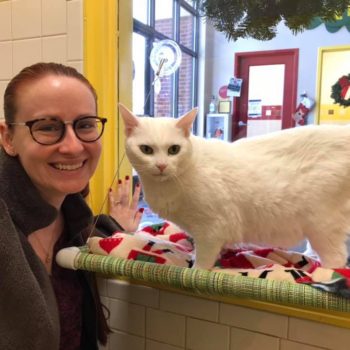Does your animal organization have a long-stay pet that seems impossible to adopt out? Nashville Humane Association shares two success stories and tips that may be just what you need.
When Angel Girl was adopted from the Nashville Humane Association in 2007, she was returned to the organization in March of 2018 after her owner was involved in a terrible car crash, sustaining injuries that prevented her from caring for her. Angel Girl also had a medical condition that made it difficult to find an adopter: she was diabetic, requiring twice-daily insulin injections.
After several months in the shelter, “It dawned on me that we should be marketing her for adoption toward those nurses and medical professionals,” says Erica Beard, Foster and Behavior Modification Coordinator at Nashville Humane Association. “I made up a quick flyer through Canva and asked my nurse, doctor and medical profession fosters to print and post it at their jobs. Within 2 hours, I had a text from a foster that her coworker, an ICU vet tech at an emergency hospital, was SUPER interested in adopting Angel Girl. She came two days later and that was that!”
Another long-stay pet, 8-year-old Michael, had been at the shelter for several months. The shelter learned a lot about his personality through their field trip program – he knew several commands, was house-trained and got along with people and pets of all kinds, but at the shelter he preferred to sleep. Potential adopters would see a sleeping dog and pass by him by.
“I made a quick sign for his kennel that basically listed all of his great qualities,” says Beard. “A couple hours later, Michael was being adopted! I asked the woman what drew her to Michael…she walked by Michael’s cage, saw him sleeping, and started to continue walking…until she saw that sign and stopped to read it.”
Want to get your long-stay pets adopted? Try these 4 strategies:
Get creative! “Even if it seems really silly or stupid, the public usually loves it,” Beard tells us. “Make that dog a resume, do a ‘day in the life’ journal, put balloons and a special sign on their kennel, use all that field trip information to figure out what their ideal home would be and target that specific demographic.”
Focus on the pets who need help the most. “We recently had a 90 lb. dog who was with us for a very long time,” Beard says. “We finally went around and took a bunch of pictures of him all around the shelter and even did a play on another post that had gotten TONS of attention (puppies in a basket – so we put all 90 lbs. of him in a basket). We decided to post at least one post about him every single day until an adopter was found. On day four, a woman who follows our pages sent her husband down to meet and adopt the dog!”
Follow other shelters and rescues Seeing how other organizations are marketing their pets can help spark your own ideas.
Ask for help. Your volunteers, fosters and supporters can be invaluable resources in creating marketing material and getting the word out about pets who need homes. Need help posting fliers, sharing a post or chatting up potential adopters about a long-stay pet? Post a request on your organization’s social media page, in your volunteer and foster social media group or send an email to ask for assistance.
By focusing on the pets who need help the most and thinking outside the box, long shelter stays for pets like Angel Girl and Michael can become a thing of the past!

